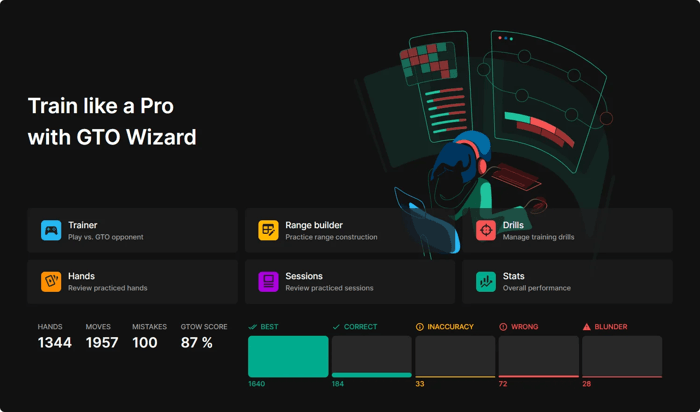Crush Poker Tournaments This Year With These 5 ICM Tips
If your goal for 2025 is to elevate your poker tournament results, mastering the Independent Chip Model (ICM) is essential.
Understanding ICM can help you make smarter decisions at every stage of a tournament, maximizing your equity and minimizing costly mistakes. Stoyan Obreshkov and GTO Wizard share five actionable tips to dominate tournaments and secure those big paydays.
Let’s dive into how you can apply these strategies right away.
Learn How to Calculate Pot Odds with GTO Wizard
1. Understand Risk Premium and Its Influencing Factors
ICM introduces the concept of risk premium—the extra equity required on top of chip EV (cEV) to account for tournament payout structures.
This means you must adjust your decisions based on more than just chip value. Key factors that influence risk premium include:
- Stack Size: Larger stacks face less risk at most stages but must weigh their equity carefully near bubbles or final tables.
- Tournament Stage: Risk premium rises sharply near the bubble and final table.
- Number of Entrants: In large-field tournaments, you can play closer to cEV early. In smaller, top-heavy tournaments, ICM adjustments begin earlier.
- Pay Structure: More top-heavy prize pools reward aggressive play for a big stack.
2. Adjust Strategy Based on Stack Size
Your stack size relative to others at the table directly impacts your approach
As a big stack, you should push aggression near the bubble to exploit smaller stacks that are focused on avoiding elimination.
In contrast, short stacks should prioritize survival during this phase, as even a marginal cash can significantly impact their equity.
Medium stacks need to play cautiously to maintain their position, especially when surrounded by a mix of large and small stacks.
A helpful tip for big stacks is to begin making ICM-based adjustments earlier in the tournament. When approximately 50% of the field remains, start tightening your range and strategically preparing for the critical bubble phase.

3. Make ICM Adjustments Earlier Than You Think
One common mistake players make is delaying ICM adjustments until they reach the bubble. If you have a large stack, you should adjust sooner. For example:
- Flatting Less: Replace speculative calls with 3-bet or fold strategies.
- Focus on Blocker Combos: Use hands like suited aces or strong offsuit broadways (e.g., Ace-Queen off) for 3-betting, especially against players with larger stacks.
- Exploit Weakness: Apply pressure on mid-stacked opponents who face difficult post-flop decisions.
- Starting earlier gives you a competitive edge and allows you to grow your chip lead strategically.
4. Rethink Flatting: Build Smarter Ranges
Flatting is often overused, especially near the bubble and final table. Instead, reduce speculative flats like suited connectors or small pairs, and shift towards 3-betting with hands that combine strong blockers and post-flop playability.
As a short stack, jamming puts pressure on opponents who must weigh risking their tournament life against your all-in move. By limiting flatting, you’ll avoid tough post-flop situations and keep control of the pot size.
5. Defend the Big Blind Effectively
Defending the big blind can make or break your tournament. Post-flop play often revolves around the big blind, so precision here is critical.
Adjust your defense based on the tournament phase. Near the bubble, tighten your range and avoid marginal calls with hands like Queen-Jack offsuit or King-Ten suited unless the price is highly favorable.
At the Final Table, defend selectively to avoid unnecessary risks. Save your stack for high-equity spots.
Use multi-way dynamics to your advantage, focusing on hands that play well against multiple players, such as suited connectors and small pairs in earlier stages. As you approach the final table, shift towards more aggressive strategies, such as bluff-heavy 3-bets with hands like Ace-Five suited that block opponents’ strong holdings.






